Critique and Comparison of Two Tourism Planning Discussion Papers
VerifiedAdded on 2022/10/02
|8
|2290
|489
Report
AI Summary
This report critically analyzes two discussion papers related to tourism planning, focusing on environmental considerations and natural resource management. The first paper, from the State Planning Commission, emphasizes the importance of environmental planning and sustainable development, addressing themes like water quality, biodiversity, and coastal environments. The second paper, concerning Kangaroo Island's natural resources, explores the island's potential as a tourist destination, highlighting its unique offerings in terms of wildlife, fisheries, and cultural experiences. The student compares the structure, quality, and suitability of the two papers, concluding that the Kangaroo Island paper is a more effective guide for environmentally planned tourism due to its detailed discussion of tourist attractions and sustainable practices. The report also acknowledges the challenges related to climate change and economic considerations. The author emphasizes the need for a balance between environmental, economic, and social aspects in tourism planning and advocates for strategies that promote the well-being of both the environment and the local community.
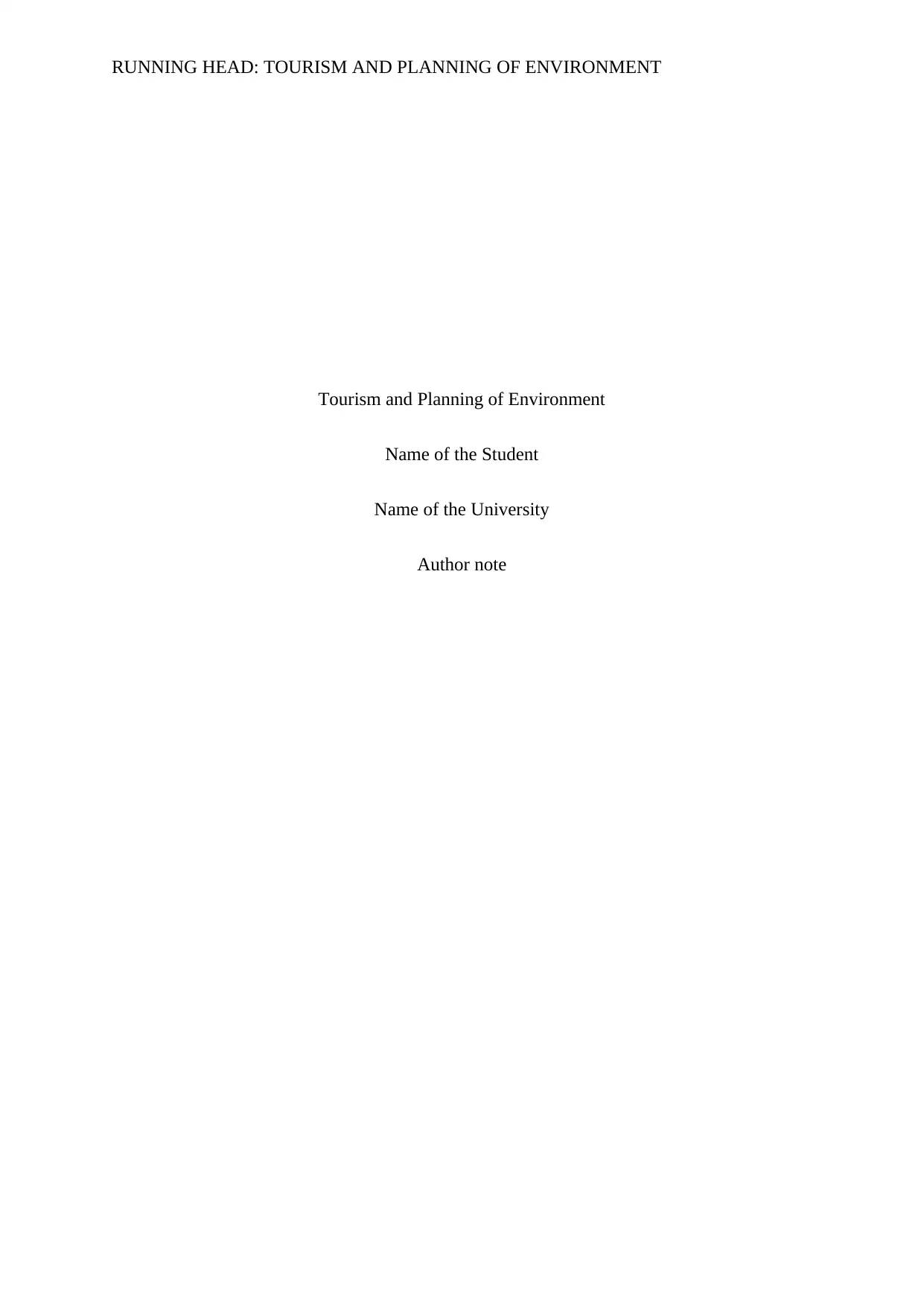
RUNNING HEAD: TOURISM AND PLANNING OF ENVIRONMENT
Tourism and Planning of Environment
Name of the Student
Name of the University
Author note
Tourism and Planning of Environment
Name of the Student
Name of the University
Author note
Paraphrase This Document
Need a fresh take? Get an instant paraphrase of this document with our AI Paraphraser
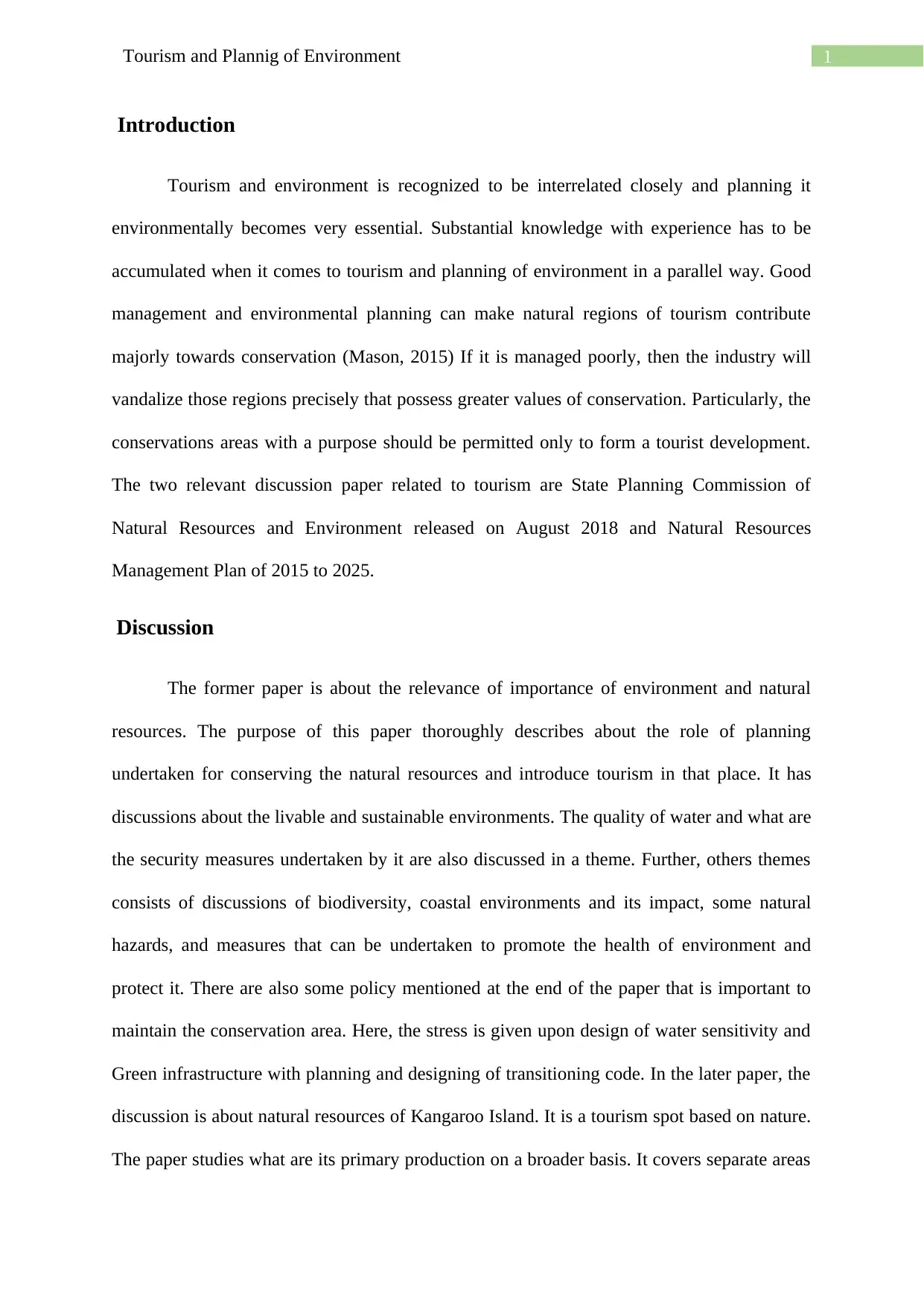
1Tourism and Plannig of Environment
Introduction
Tourism and environment is recognized to be interrelated closely and planning it
environmentally becomes very essential. Substantial knowledge with experience has to be
accumulated when it comes to tourism and planning of environment in a parallel way. Good
management and environmental planning can make natural regions of tourism contribute
majorly towards conservation (Mason, 2015) If it is managed poorly, then the industry will
vandalize those regions precisely that possess greater values of conservation. Particularly, the
conservations areas with a purpose should be permitted only to form a tourist development.
The two relevant discussion paper related to tourism are State Planning Commission of
Natural Resources and Environment released on August 2018 and Natural Resources
Management Plan of 2015 to 2025.
Discussion
The former paper is about the relevance of importance of environment and natural
resources. The purpose of this paper thoroughly describes about the role of planning
undertaken for conserving the natural resources and introduce tourism in that place. It has
discussions about the livable and sustainable environments. The quality of water and what are
the security measures undertaken by it are also discussed in a theme. Further, others themes
consists of discussions of biodiversity, coastal environments and its impact, some natural
hazards, and measures that can be undertaken to promote the health of environment and
protect it. There are also some policy mentioned at the end of the paper that is important to
maintain the conservation area. Here, the stress is given upon design of water sensitivity and
Green infrastructure with planning and designing of transitioning code. In the later paper, the
discussion is about natural resources of Kangaroo Island. It is a tourism spot based on nature.
The paper studies what are its primary production on a broader basis. It covers separate areas
Introduction
Tourism and environment is recognized to be interrelated closely and planning it
environmentally becomes very essential. Substantial knowledge with experience has to be
accumulated when it comes to tourism and planning of environment in a parallel way. Good
management and environmental planning can make natural regions of tourism contribute
majorly towards conservation (Mason, 2015) If it is managed poorly, then the industry will
vandalize those regions precisely that possess greater values of conservation. Particularly, the
conservations areas with a purpose should be permitted only to form a tourist development.
The two relevant discussion paper related to tourism are State Planning Commission of
Natural Resources and Environment released on August 2018 and Natural Resources
Management Plan of 2015 to 2025.
Discussion
The former paper is about the relevance of importance of environment and natural
resources. The purpose of this paper thoroughly describes about the role of planning
undertaken for conserving the natural resources and introduce tourism in that place. It has
discussions about the livable and sustainable environments. The quality of water and what are
the security measures undertaken by it are also discussed in a theme. Further, others themes
consists of discussions of biodiversity, coastal environments and its impact, some natural
hazards, and measures that can be undertaken to promote the health of environment and
protect it. There are also some policy mentioned at the end of the paper that is important to
maintain the conservation area. Here, the stress is given upon design of water sensitivity and
Green infrastructure with planning and designing of transitioning code. In the later paper, the
discussion is about natural resources of Kangaroo Island. It is a tourism spot based on nature.
The paper studies what are its primary production on a broader basis. It covers separate areas
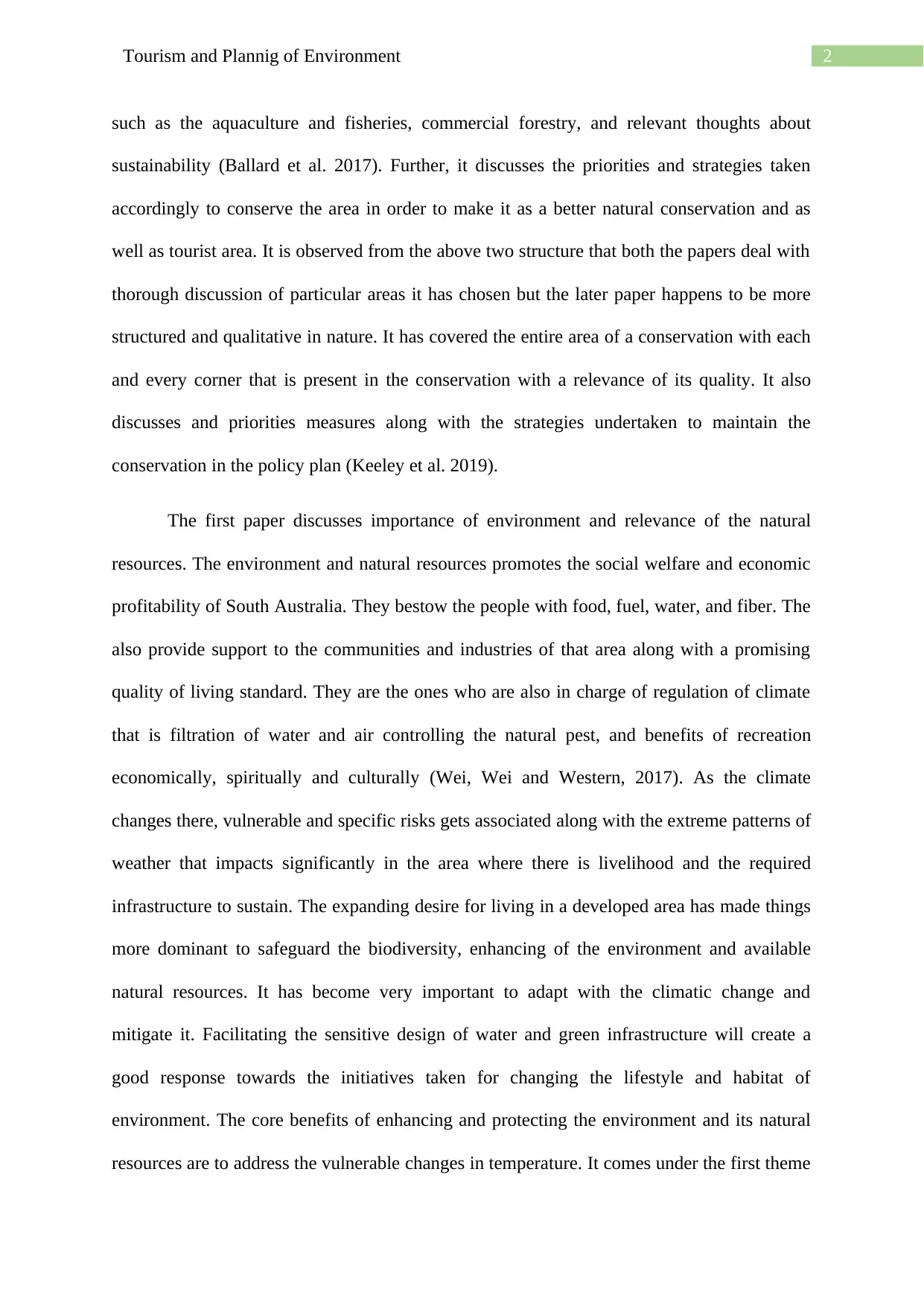
2Tourism and Plannig of Environment
such as the aquaculture and fisheries, commercial forestry, and relevant thoughts about
sustainability (Ballard et al. 2017). Further, it discusses the priorities and strategies taken
accordingly to conserve the area in order to make it as a better natural conservation and as
well as tourist area. It is observed from the above two structure that both the papers deal with
thorough discussion of particular areas it has chosen but the later paper happens to be more
structured and qualitative in nature. It has covered the entire area of a conservation with each
and every corner that is present in the conservation with a relevance of its quality. It also
discusses and priorities measures along with the strategies undertaken to maintain the
conservation in the policy plan (Keeley et al. 2019).
The first paper discusses importance of environment and relevance of the natural
resources. The environment and natural resources promotes the social welfare and economic
profitability of South Australia. They bestow the people with food, fuel, water, and fiber. The
also provide support to the communities and industries of that area along with a promising
quality of living standard. They are the ones who are also in charge of regulation of climate
that is filtration of water and air controlling the natural pest, and benefits of recreation
economically, spiritually and culturally (Wei, Wei and Western, 2017). As the climate
changes there, vulnerable and specific risks gets associated along with the extreme patterns of
weather that impacts significantly in the area where there is livelihood and the required
infrastructure to sustain. The expanding desire for living in a developed area has made things
more dominant to safeguard the biodiversity, enhancing of the environment and available
natural resources. It has become very important to adapt with the climatic change and
mitigate it. Facilitating the sensitive design of water and green infrastructure will create a
good response towards the initiatives taken for changing the lifestyle and habitat of
environment. The core benefits of enhancing and protecting the environment and its natural
resources are to address the vulnerable changes in temperature. It comes under the first theme
such as the aquaculture and fisheries, commercial forestry, and relevant thoughts about
sustainability (Ballard et al. 2017). Further, it discusses the priorities and strategies taken
accordingly to conserve the area in order to make it as a better natural conservation and as
well as tourist area. It is observed from the above two structure that both the papers deal with
thorough discussion of particular areas it has chosen but the later paper happens to be more
structured and qualitative in nature. It has covered the entire area of a conservation with each
and every corner that is present in the conservation with a relevance of its quality. It also
discusses and priorities measures along with the strategies undertaken to maintain the
conservation in the policy plan (Keeley et al. 2019).
The first paper discusses importance of environment and relevance of the natural
resources. The environment and natural resources promotes the social welfare and economic
profitability of South Australia. They bestow the people with food, fuel, water, and fiber. The
also provide support to the communities and industries of that area along with a promising
quality of living standard. They are the ones who are also in charge of regulation of climate
that is filtration of water and air controlling the natural pest, and benefits of recreation
economically, spiritually and culturally (Wei, Wei and Western, 2017). As the climate
changes there, vulnerable and specific risks gets associated along with the extreme patterns of
weather that impacts significantly in the area where there is livelihood and the required
infrastructure to sustain. The expanding desire for living in a developed area has made things
more dominant to safeguard the biodiversity, enhancing of the environment and available
natural resources. It has become very important to adapt with the climatic change and
mitigate it. Facilitating the sensitive design of water and green infrastructure will create a
good response towards the initiatives taken for changing the lifestyle and habitat of
environment. The core benefits of enhancing and protecting the environment and its natural
resources are to address the vulnerable changes in temperature. It comes under the first theme
⊘ This is a preview!⊘
Do you want full access?
Subscribe today to unlock all pages.

Trusted by 1+ million students worldwide
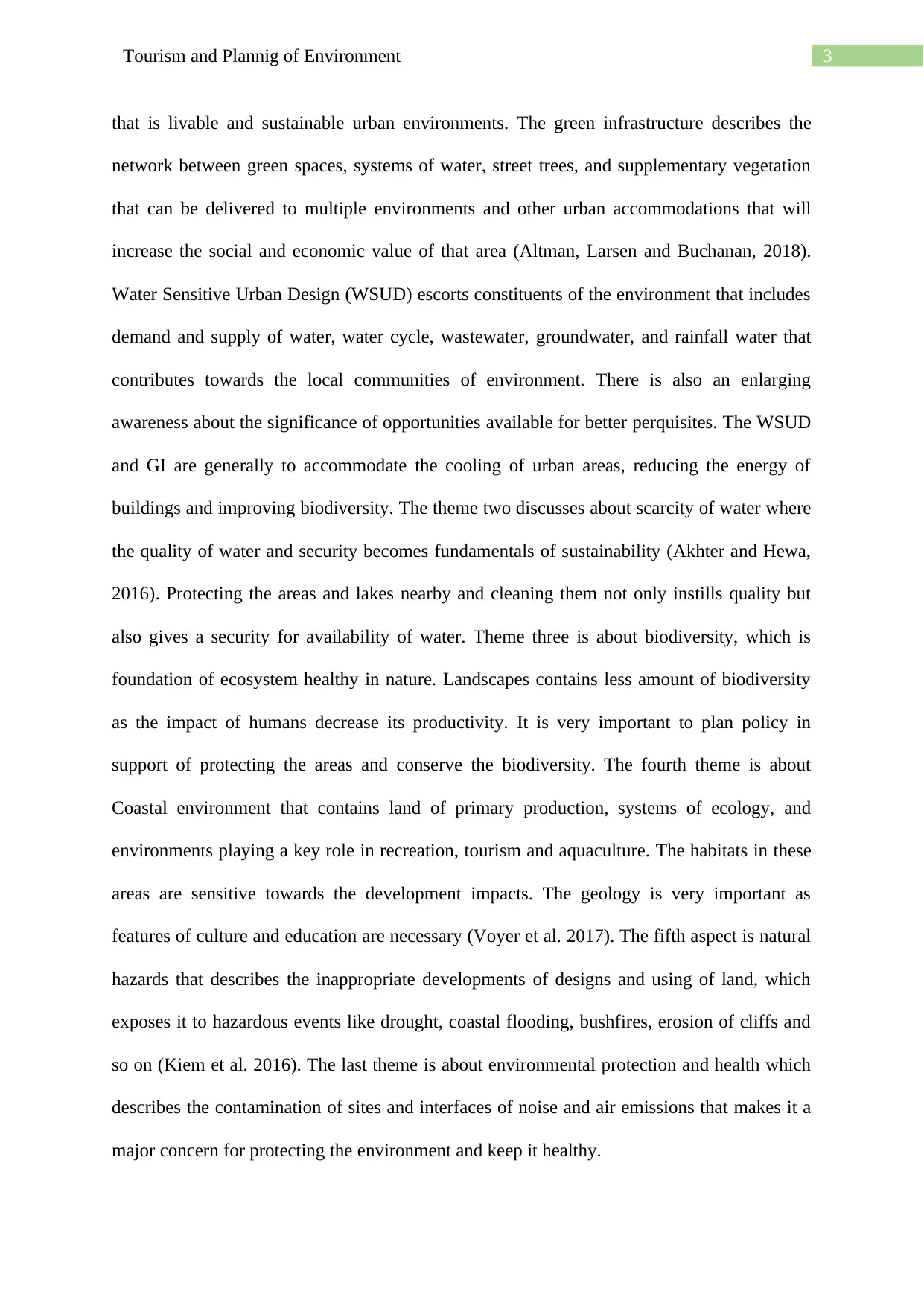
3Tourism and Plannig of Environment
that is livable and sustainable urban environments. The green infrastructure describes the
network between green spaces, systems of water, street trees, and supplementary vegetation
that can be delivered to multiple environments and other urban accommodations that will
increase the social and economic value of that area (Altman, Larsen and Buchanan, 2018).
Water Sensitive Urban Design (WSUD) escorts constituents of the environment that includes
demand and supply of water, water cycle, wastewater, groundwater, and rainfall water that
contributes towards the local communities of environment. There is also an enlarging
awareness about the significance of opportunities available for better perquisites. The WSUD
and GI are generally to accommodate the cooling of urban areas, reducing the energy of
buildings and improving biodiversity. The theme two discusses about scarcity of water where
the quality of water and security becomes fundamentals of sustainability (Akhter and Hewa,
2016). Protecting the areas and lakes nearby and cleaning them not only instills quality but
also gives a security for availability of water. Theme three is about biodiversity, which is
foundation of ecosystem healthy in nature. Landscapes contains less amount of biodiversity
as the impact of humans decrease its productivity. It is very important to plan policy in
support of protecting the areas and conserve the biodiversity. The fourth theme is about
Coastal environment that contains land of primary production, systems of ecology, and
environments playing a key role in recreation, tourism and aquaculture. The habitats in these
areas are sensitive towards the development impacts. The geology is very important as
features of culture and education are necessary (Voyer et al. 2017). The fifth aspect is natural
hazards that describes the inappropriate developments of designs and using of land, which
exposes it to hazardous events like drought, coastal flooding, bushfires, erosion of cliffs and
so on (Kiem et al. 2016). The last theme is about environmental protection and health which
describes the contamination of sites and interfaces of noise and air emissions that makes it a
major concern for protecting the environment and keep it healthy.
that is livable and sustainable urban environments. The green infrastructure describes the
network between green spaces, systems of water, street trees, and supplementary vegetation
that can be delivered to multiple environments and other urban accommodations that will
increase the social and economic value of that area (Altman, Larsen and Buchanan, 2018).
Water Sensitive Urban Design (WSUD) escorts constituents of the environment that includes
demand and supply of water, water cycle, wastewater, groundwater, and rainfall water that
contributes towards the local communities of environment. There is also an enlarging
awareness about the significance of opportunities available for better perquisites. The WSUD
and GI are generally to accommodate the cooling of urban areas, reducing the energy of
buildings and improving biodiversity. The theme two discusses about scarcity of water where
the quality of water and security becomes fundamentals of sustainability (Akhter and Hewa,
2016). Protecting the areas and lakes nearby and cleaning them not only instills quality but
also gives a security for availability of water. Theme three is about biodiversity, which is
foundation of ecosystem healthy in nature. Landscapes contains less amount of biodiversity
as the impact of humans decrease its productivity. It is very important to plan policy in
support of protecting the areas and conserve the biodiversity. The fourth theme is about
Coastal environment that contains land of primary production, systems of ecology, and
environments playing a key role in recreation, tourism and aquaculture. The habitats in these
areas are sensitive towards the development impacts. The geology is very important as
features of culture and education are necessary (Voyer et al. 2017). The fifth aspect is natural
hazards that describes the inappropriate developments of designs and using of land, which
exposes it to hazardous events like drought, coastal flooding, bushfires, erosion of cliffs and
so on (Kiem et al. 2016). The last theme is about environmental protection and health which
describes the contamination of sites and interfaces of noise and air emissions that makes it a
major concern for protecting the environment and keep it healthy.
Paraphrase This Document
Need a fresh take? Get an instant paraphrase of this document with our AI Paraphraser
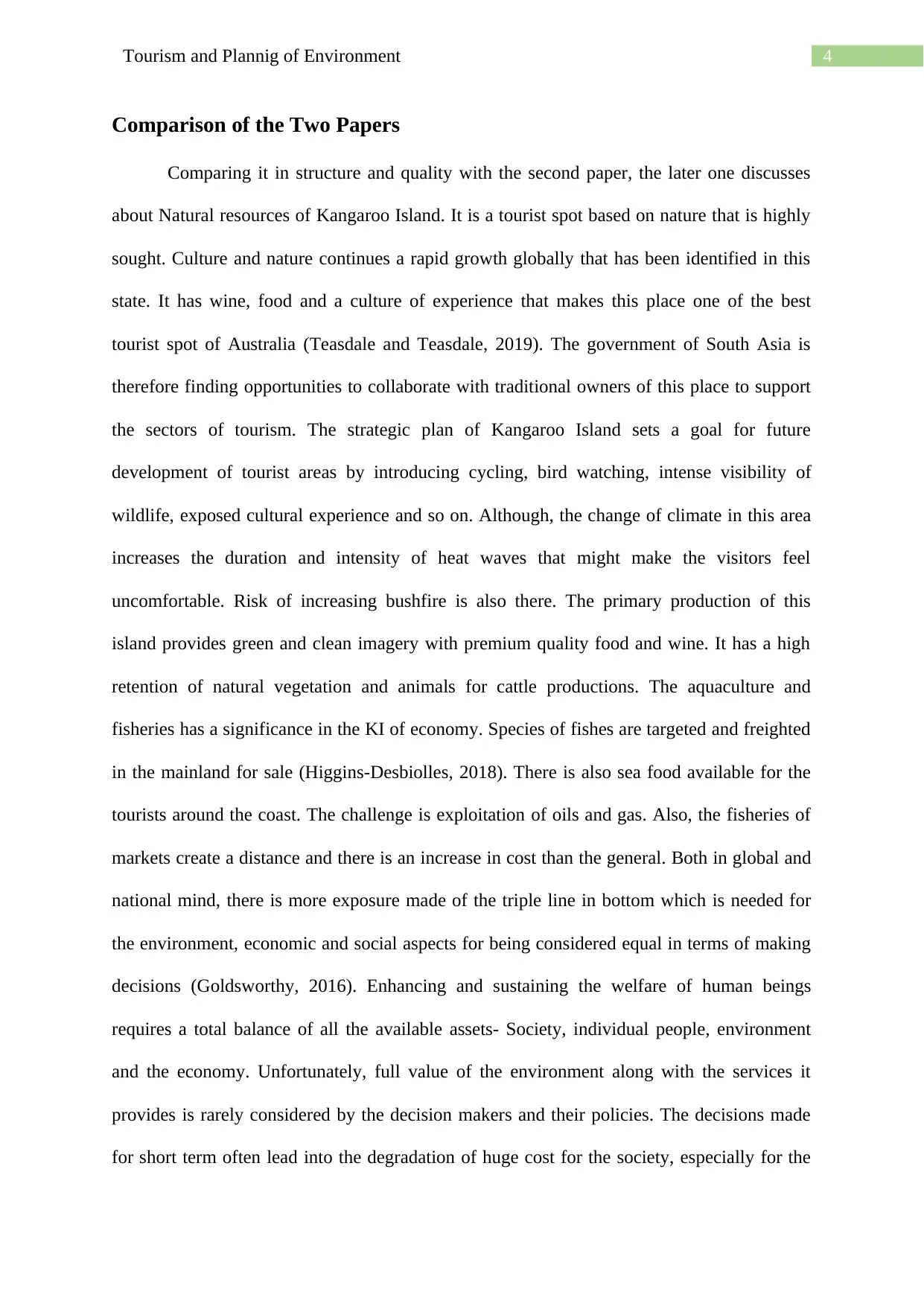
4Tourism and Plannig of Environment
Comparison of the Two Papers
Comparing it in structure and quality with the second paper, the later one discusses
about Natural resources of Kangaroo Island. It is a tourist spot based on nature that is highly
sought. Culture and nature continues a rapid growth globally that has been identified in this
state. It has wine, food and a culture of experience that makes this place one of the best
tourist spot of Australia (Teasdale and Teasdale, 2019). The government of South Asia is
therefore finding opportunities to collaborate with traditional owners of this place to support
the sectors of tourism. The strategic plan of Kangaroo Island sets a goal for future
development of tourist areas by introducing cycling, bird watching, intense visibility of
wildlife, exposed cultural experience and so on. Although, the change of climate in this area
increases the duration and intensity of heat waves that might make the visitors feel
uncomfortable. Risk of increasing bushfire is also there. The primary production of this
island provides green and clean imagery with premium quality food and wine. It has a high
retention of natural vegetation and animals for cattle productions. The aquaculture and
fisheries has a significance in the KI of economy. Species of fishes are targeted and freighted
in the mainland for sale (Higgins-Desbiolles, 2018). There is also sea food available for the
tourists around the coast. The challenge is exploitation of oils and gas. Also, the fisheries of
markets create a distance and there is an increase in cost than the general. Both in global and
national mind, there is more exposure made of the triple line in bottom which is needed for
the environment, economic and social aspects for being considered equal in terms of making
decisions (Goldsworthy, 2016). Enhancing and sustaining the welfare of human beings
requires a total balance of all the available assets- Society, individual people, environment
and the economy. Unfortunately, full value of the environment along with the services it
provides is rarely considered by the decision makers and their policies. The decisions made
for short term often lead into the degradation of huge cost for the society, especially for the
Comparison of the Two Papers
Comparing it in structure and quality with the second paper, the later one discusses
about Natural resources of Kangaroo Island. It is a tourist spot based on nature that is highly
sought. Culture and nature continues a rapid growth globally that has been identified in this
state. It has wine, food and a culture of experience that makes this place one of the best
tourist spot of Australia (Teasdale and Teasdale, 2019). The government of South Asia is
therefore finding opportunities to collaborate with traditional owners of this place to support
the sectors of tourism. The strategic plan of Kangaroo Island sets a goal for future
development of tourist areas by introducing cycling, bird watching, intense visibility of
wildlife, exposed cultural experience and so on. Although, the change of climate in this area
increases the duration and intensity of heat waves that might make the visitors feel
uncomfortable. Risk of increasing bushfire is also there. The primary production of this
island provides green and clean imagery with premium quality food and wine. It has a high
retention of natural vegetation and animals for cattle productions. The aquaculture and
fisheries has a significance in the KI of economy. Species of fishes are targeted and freighted
in the mainland for sale (Higgins-Desbiolles, 2018). There is also sea food available for the
tourists around the coast. The challenge is exploitation of oils and gas. Also, the fisheries of
markets create a distance and there is an increase in cost than the general. Both in global and
national mind, there is more exposure made of the triple line in bottom which is needed for
the environment, economic and social aspects for being considered equal in terms of making
decisions (Goldsworthy, 2016). Enhancing and sustaining the welfare of human beings
requires a total balance of all the available assets- Society, individual people, environment
and the economy. Unfortunately, full value of the environment along with the services it
provides is rarely considered by the decision makers and their policies. The decisions made
for short term often lead into the degradation of huge cost for the society, especially for the
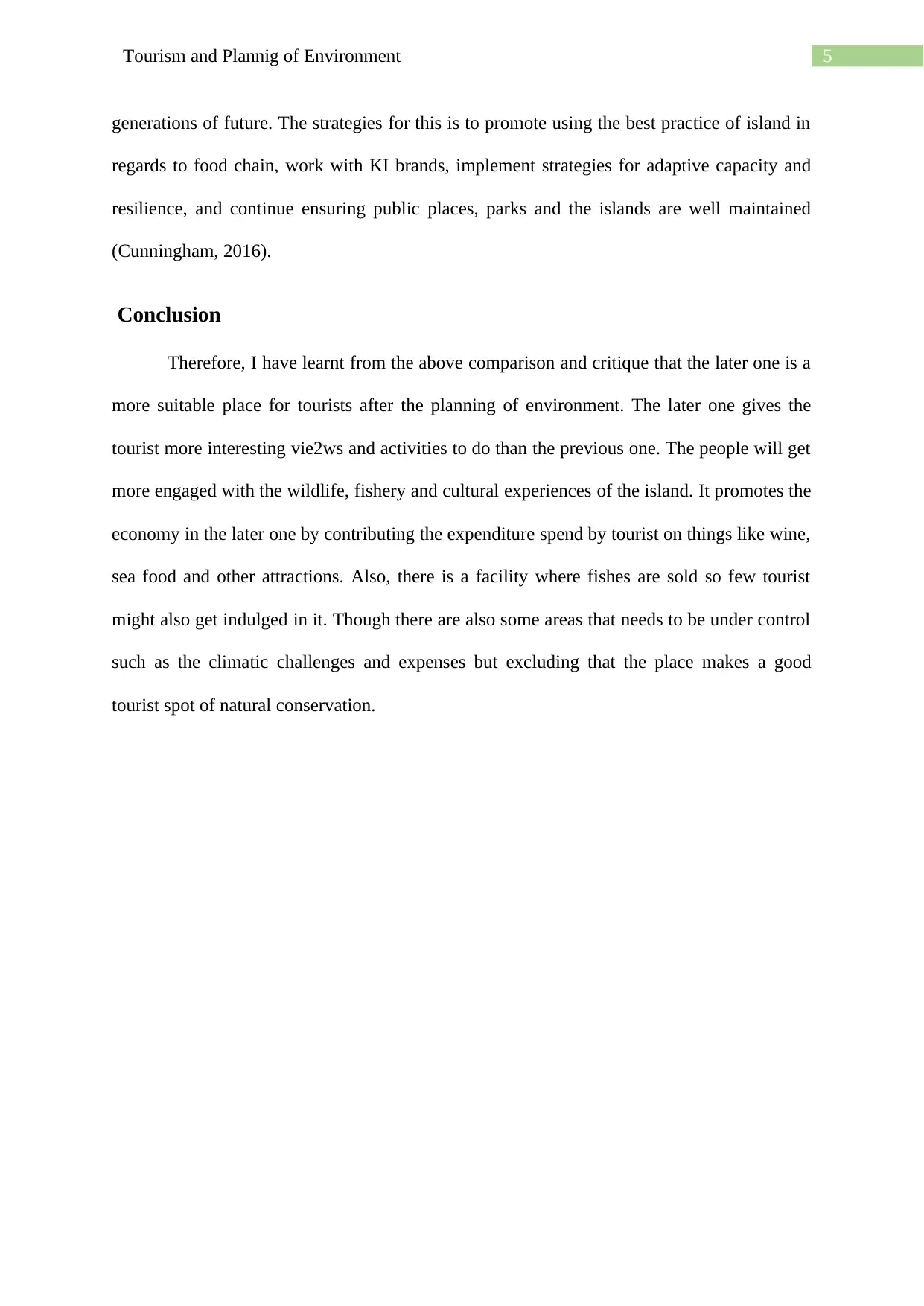
5Tourism and Plannig of Environment
generations of future. The strategies for this is to promote using the best practice of island in
regards to food chain, work with KI brands, implement strategies for adaptive capacity and
resilience, and continue ensuring public places, parks and the islands are well maintained
(Cunningham, 2016).
Conclusion
Therefore, I have learnt from the above comparison and critique that the later one is a
more suitable place for tourists after the planning of environment. The later one gives the
tourist more interesting vie2ws and activities to do than the previous one. The people will get
more engaged with the wildlife, fishery and cultural experiences of the island. It promotes the
economy in the later one by contributing the expenditure spend by tourist on things like wine,
sea food and other attractions. Also, there is a facility where fishes are sold so few tourist
might also get indulged in it. Though there are also some areas that needs to be under control
such as the climatic challenges and expenses but excluding that the place makes a good
tourist spot of natural conservation.
generations of future. The strategies for this is to promote using the best practice of island in
regards to food chain, work with KI brands, implement strategies for adaptive capacity and
resilience, and continue ensuring public places, parks and the islands are well maintained
(Cunningham, 2016).
Conclusion
Therefore, I have learnt from the above comparison and critique that the later one is a
more suitable place for tourists after the planning of environment. The later one gives the
tourist more interesting vie2ws and activities to do than the previous one. The people will get
more engaged with the wildlife, fishery and cultural experiences of the island. It promotes the
economy in the later one by contributing the expenditure spend by tourist on things like wine,
sea food and other attractions. Also, there is a facility where fishes are sold so few tourist
might also get indulged in it. Though there are also some areas that needs to be under control
such as the climatic challenges and expenses but excluding that the place makes a good
tourist spot of natural conservation.
⊘ This is a preview!⊘
Do you want full access?
Subscribe today to unlock all pages.

Trusted by 1+ million students worldwide
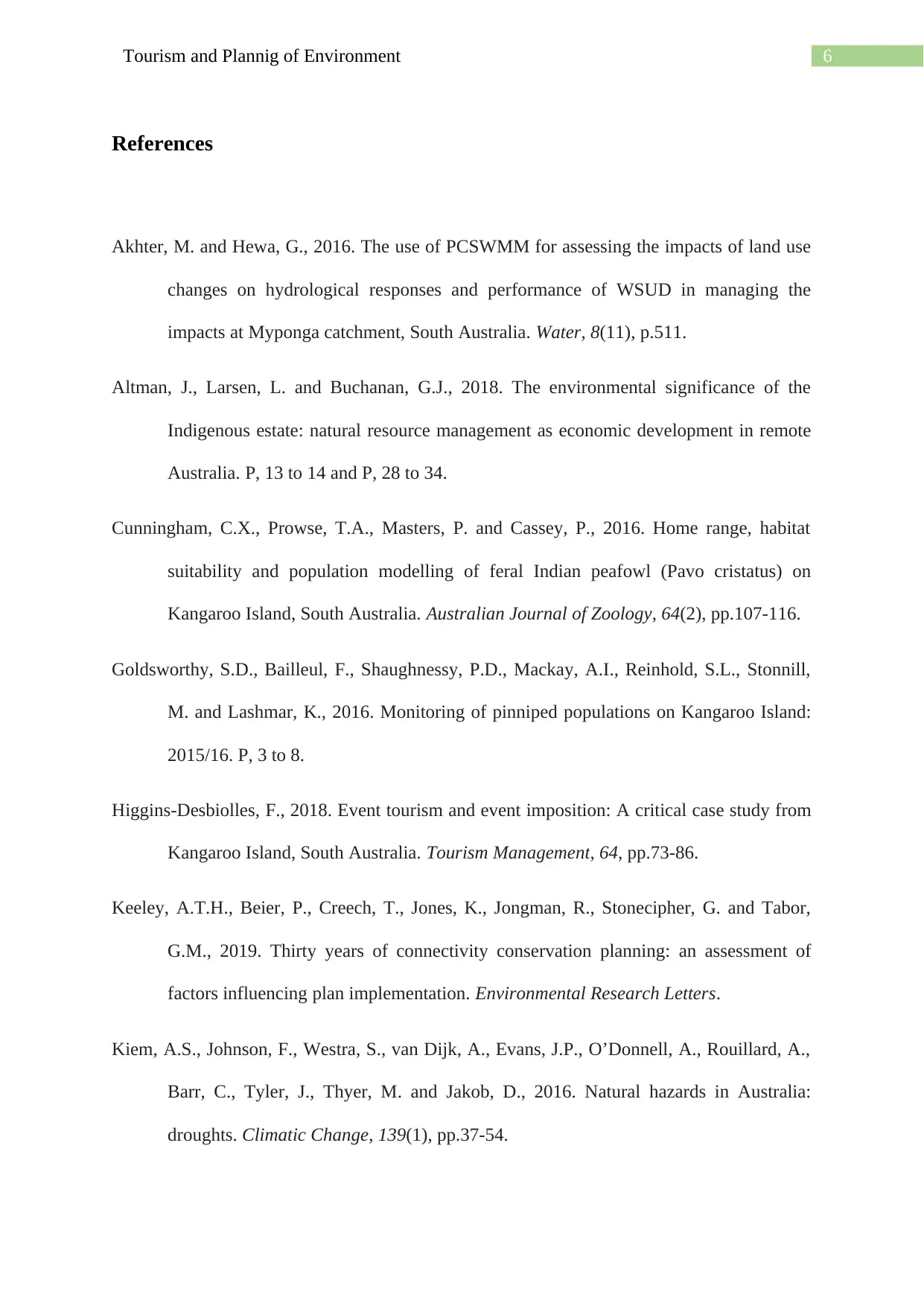
6Tourism and Plannig of Environment
References
Akhter, M. and Hewa, G., 2016. The use of PCSWMM for assessing the impacts of land use
changes on hydrological responses and performance of WSUD in managing the
impacts at Myponga catchment, South Australia. Water, 8(11), p.511.
Altman, J., Larsen, L. and Buchanan, G.J., 2018. The environmental significance of the
Indigenous estate: natural resource management as economic development in remote
Australia. P, 13 to 14 and P, 28 to 34.
Cunningham, C.X., Prowse, T.A., Masters, P. and Cassey, P., 2016. Home range, habitat
suitability and population modelling of feral Indian peafowl (Pavo cristatus) on
Kangaroo Island, South Australia. Australian Journal of Zoology, 64(2), pp.107-116.
Goldsworthy, S.D., Bailleul, F., Shaughnessy, P.D., Mackay, A.I., Reinhold, S.L., Stonnill,
M. and Lashmar, K., 2016. Monitoring of pinniped populations on Kangaroo Island:
2015/16. P, 3 to 8.
Higgins-Desbiolles, F., 2018. Event tourism and event imposition: A critical case study from
Kangaroo Island, South Australia. Tourism Management, 64, pp.73-86.
Keeley, A.T.H., Beier, P., Creech, T., Jones, K., Jongman, R., Stonecipher, G. and Tabor,
G.M., 2019. Thirty years of connectivity conservation planning: an assessment of
factors influencing plan implementation. Environmental Research Letters.
Kiem, A.S., Johnson, F., Westra, S., van Dijk, A., Evans, J.P., O’Donnell, A., Rouillard, A.,
Barr, C., Tyler, J., Thyer, M. and Jakob, D., 2016. Natural hazards in Australia:
droughts. Climatic Change, 139(1), pp.37-54.
References
Akhter, M. and Hewa, G., 2016. The use of PCSWMM for assessing the impacts of land use
changes on hydrological responses and performance of WSUD in managing the
impacts at Myponga catchment, South Australia. Water, 8(11), p.511.
Altman, J., Larsen, L. and Buchanan, G.J., 2018. The environmental significance of the
Indigenous estate: natural resource management as economic development in remote
Australia. P, 13 to 14 and P, 28 to 34.
Cunningham, C.X., Prowse, T.A., Masters, P. and Cassey, P., 2016. Home range, habitat
suitability and population modelling of feral Indian peafowl (Pavo cristatus) on
Kangaroo Island, South Australia. Australian Journal of Zoology, 64(2), pp.107-116.
Goldsworthy, S.D., Bailleul, F., Shaughnessy, P.D., Mackay, A.I., Reinhold, S.L., Stonnill,
M. and Lashmar, K., 2016. Monitoring of pinniped populations on Kangaroo Island:
2015/16. P, 3 to 8.
Higgins-Desbiolles, F., 2018. Event tourism and event imposition: A critical case study from
Kangaroo Island, South Australia. Tourism Management, 64, pp.73-86.
Keeley, A.T.H., Beier, P., Creech, T., Jones, K., Jongman, R., Stonecipher, G. and Tabor,
G.M., 2019. Thirty years of connectivity conservation planning: an assessment of
factors influencing plan implementation. Environmental Research Letters.
Kiem, A.S., Johnson, F., Westra, S., van Dijk, A., Evans, J.P., O’Donnell, A., Rouillard, A.,
Barr, C., Tyler, J., Thyer, M. and Jakob, D., 2016. Natural hazards in Australia:
droughts. Climatic Change, 139(1), pp.37-54.
Paraphrase This Document
Need a fresh take? Get an instant paraphrase of this document with our AI Paraphraser
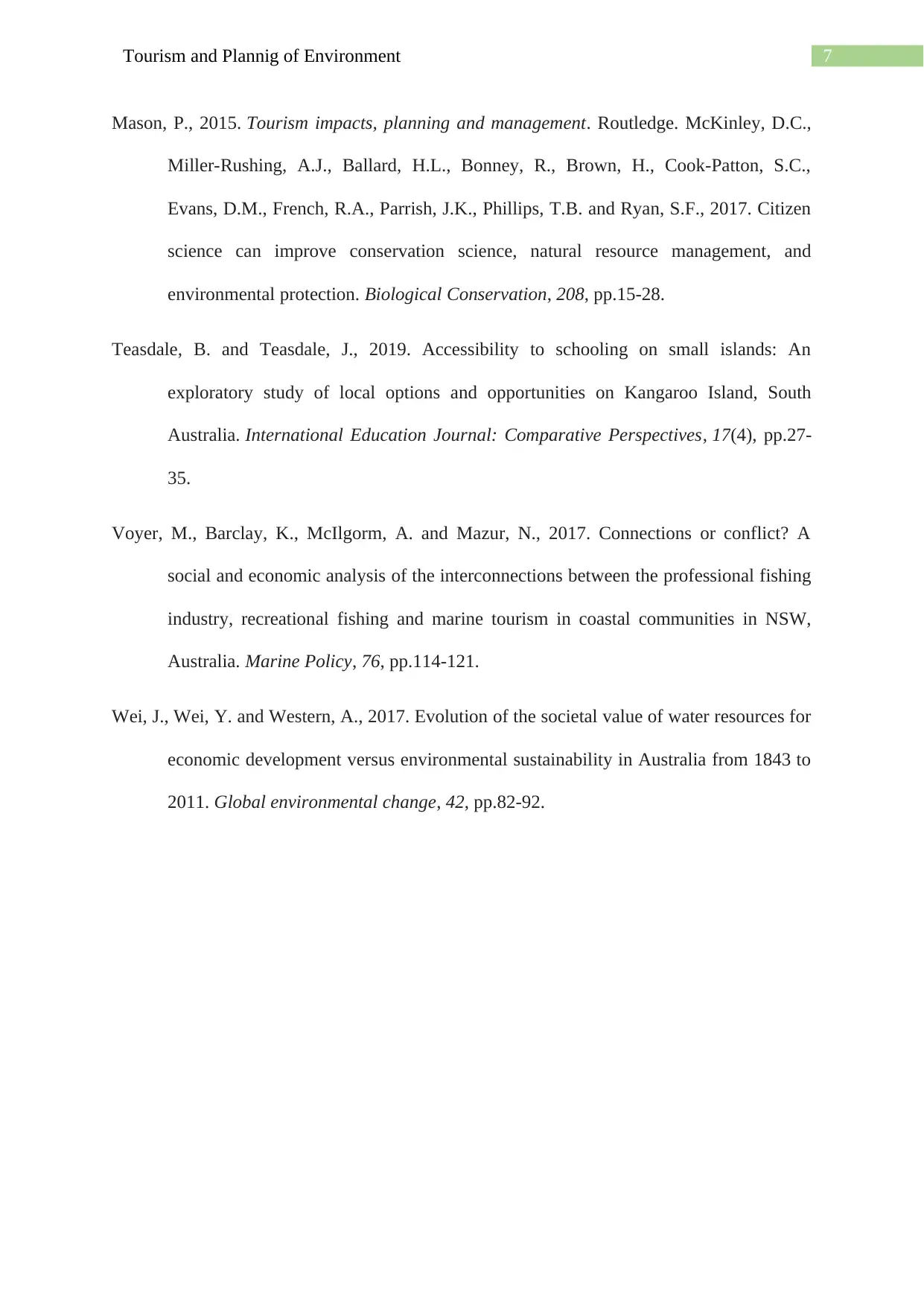
7Tourism and Plannig of Environment
Mason, P., 2015. Tourism impacts, planning and management. Routledge. McKinley, D.C.,
Miller-Rushing, A.J., Ballard, H.L., Bonney, R., Brown, H., Cook-Patton, S.C.,
Evans, D.M., French, R.A., Parrish, J.K., Phillips, T.B. and Ryan, S.F., 2017. Citizen
science can improve conservation science, natural resource management, and
environmental protection. Biological Conservation, 208, pp.15-28.
Teasdale, B. and Teasdale, J., 2019. Accessibility to schooling on small islands: An
exploratory study of local options and opportunities on Kangaroo Island, South
Australia. International Education Journal: Comparative Perspectives, 17(4), pp.27-
35.
Voyer, M., Barclay, K., McIlgorm, A. and Mazur, N., 2017. Connections or conflict? A
social and economic analysis of the interconnections between the professional fishing
industry, recreational fishing and marine tourism in coastal communities in NSW,
Australia. Marine Policy, 76, pp.114-121.
Wei, J., Wei, Y. and Western, A., 2017. Evolution of the societal value of water resources for
economic development versus environmental sustainability in Australia from 1843 to
2011. Global environmental change, 42, pp.82-92.
Mason, P., 2015. Tourism impacts, planning and management. Routledge. McKinley, D.C.,
Miller-Rushing, A.J., Ballard, H.L., Bonney, R., Brown, H., Cook-Patton, S.C.,
Evans, D.M., French, R.A., Parrish, J.K., Phillips, T.B. and Ryan, S.F., 2017. Citizen
science can improve conservation science, natural resource management, and
environmental protection. Biological Conservation, 208, pp.15-28.
Teasdale, B. and Teasdale, J., 2019. Accessibility to schooling on small islands: An
exploratory study of local options and opportunities on Kangaroo Island, South
Australia. International Education Journal: Comparative Perspectives, 17(4), pp.27-
35.
Voyer, M., Barclay, K., McIlgorm, A. and Mazur, N., 2017. Connections or conflict? A
social and economic analysis of the interconnections between the professional fishing
industry, recreational fishing and marine tourism in coastal communities in NSW,
Australia. Marine Policy, 76, pp.114-121.
Wei, J., Wei, Y. and Western, A., 2017. Evolution of the societal value of water resources for
economic development versus environmental sustainability in Australia from 1843 to
2011. Global environmental change, 42, pp.82-92.
1 out of 8
Related Documents
Your All-in-One AI-Powered Toolkit for Academic Success.
+13062052269
info@desklib.com
Available 24*7 on WhatsApp / Email
![[object Object]](/_next/static/media/star-bottom.7253800d.svg)
Unlock your academic potential
Copyright © 2020–2025 A2Z Services. All Rights Reserved. Developed and managed by ZUCOL.





